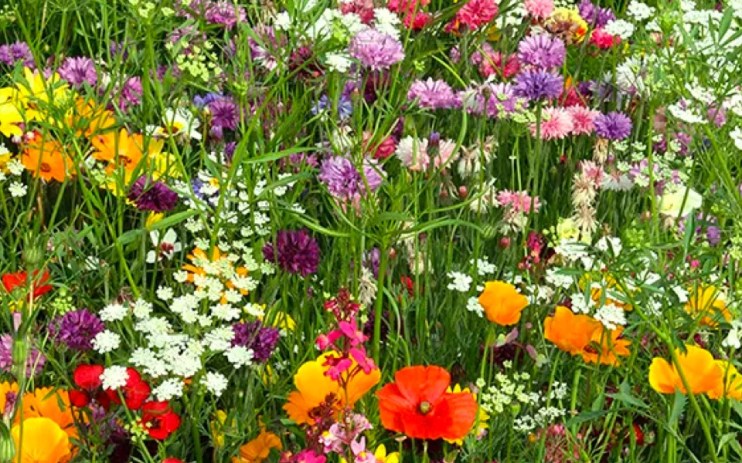The man who transforms grey urban spaces into green oases

The last year has taught us the importance of outdoor spaces, little oases of green amid the grey expanse of the city where we can safely meet even during a pandemic. But what exactly goes into creating such a space? We caught up with someone who knows: Nigel Dunnett, professor of Planting Design, Urban Horticulture and Vegetation Technology at the University of Sheffield.
His credentials speak for themselves: he installed Buckingham Palace’s Diamond Garden to commemorate the 60th anniversary of Queen Elizabeth’s accession to the throne; he was responsible for the Barbican planting after 2013; he’s a gold-winning Chelsea Flower Show entry; and he planted London’s Olympic Park, the UK’s largest urban green space and the first created for 150 years, alongside Prof James Hitchmough.
“The promotion of urban environments that are rich in vegetation and nature is central to my teaching and research,” says Dunnett. “I specialise in planting design as both an art form, applying ecological concepts to create dynamic, dramatic and uplifting landscapes. I try to find every opportunity to introduce exciting planting into cities to meet the challenges of climate-change and urbanisation.”
Dunnett, who is also the Royal Horticultural Society’s Ambassador for Greening Grey Britain, is also responsible for many smaller projects, including rewilding unloved patches of urban land. Working in partnership with local authorities throughout the UK and now Europe, his Pictorial Meadows project has transformed a series of roundabouts and verges into natural wildflower gardens, promoting biodiversity. One Borough Council sowed eight miles of verges with wildflowers, transforming eyesores into little slices of nature.
“I’ve been part of the movement that has operated in Europe and North America for the last two decades, promoting a more relaxed and naturalistic approach to urban public plantings, and gaining inspiration from the structure and processes in natural vegetation systems.”
An initial three year strategy of transforming wasteland into vast inner city, seed sown meadows started in Sheffield in 2004. Schools and community groups were involved in sowing seeds and neighbourhoods were transformed in both appearance and in terms of a marked reduction in antisocial behaviour.
“Initially it was about developing visually beautiful meadows that would thrive on average garden soils but not require the starvation regime normally associated with traditional wildflower meadows. A radically different approach to meadow landscapes emerged combining ecology with design. Experimental plots soon spread outside of Sheffield. People got the picture!”
Pictorial Meadows now employs landscape architects, horticulturalists, landscape managers and experts in low input, high impact meadow creation and care. Clients include private landowners; commercial organisations including The John Lewis Rain Garden; two hundred councils, golf courses in Scotland, Poland and Slovakia; the National Trust; Sky UK (for its prestigious five hectare campus); Nottingham Trent University; Richmond Park; south Tyneside (63 sites across 17 wards); Carbrook Ravine; and a former deer park in Yorkshire. The project has even gone international, with local park development in Madrid alongside local landscape architect Miguel Garcia Ovejero.
“The original brief was to create a district park from an abandoned and abused landscape in what had been described as “the worst estate in Britain”. It’s now a Green Fields site and still our test site for seed-sown landscapes.”
Dunnett says his project isn’t just about making sites look nicer: “We deliver long-term benefits to communities, particularly in urban areas. We don’t just prettify dual carriageways. Sheffield City Council had over 300 hectares of brownfield sites awaiting housing redevelopment. These sites were magnets for fly-tipping and antisocial behaviour. The quality of life for residents was low. It was a challenging public realm!
“We wanted it to be a demonstration of a whole new approach to the design and management of public landscapes: where ecology and sustainability is at the forefront, combined with a strong aesthetic. Over the years we’ve revitalised conservation ponds and wetlands. We are now virtually semi-aquatic! We work with the charity Froglife creating diverse watery habitats for our threatened amphibians. We sensitively clear encroaching vegetation, dredge and redistribute the silt and translocate the resulting wetland edge material afterwards. We run an annual photographic competition where we invite our customers to submit pictures of their home-grown meadows.”
Early efforts to replicate meadows in garden and city landscapes often failed. A lack of understanding about meadow ecology resulted in seed mixes that were never formulated to thrive in normal fertility soils. Traditional low fertility wildflower meadows necessitate major re-landscaping efforts to try and emulate the stressed soil conditions that wildflowers need to out compete with rampant grasses and domineering weed species. But the process of greening grey has now been perfected, with results almost instant, with flowers blooming from early spring to late autumn.
“Long season interest, colour and good structure are vitally important,” says Dunnett. “Most people want the look now, and not in ten years’ time! We now offer customers naturalistic but idealised meadow-like landscapes that establish relatively rapidly, perform well in normal conditions and provide pleasure for a long period. We build compositions with a high percentage of fine foliage and dainty flower heads but deliberately exclude most grasses and bulky flower forms from our mixes as they all too quickly swamp the more desirable species.”
And if you live near to a wasteland that would look better as a green meadow, perhaps Dunnett can help you, too. “We always want to hear from anyone wanting to convert ugly derelict sites into beautiful urban spaces and make roundabouts more pleasant places to be around.”